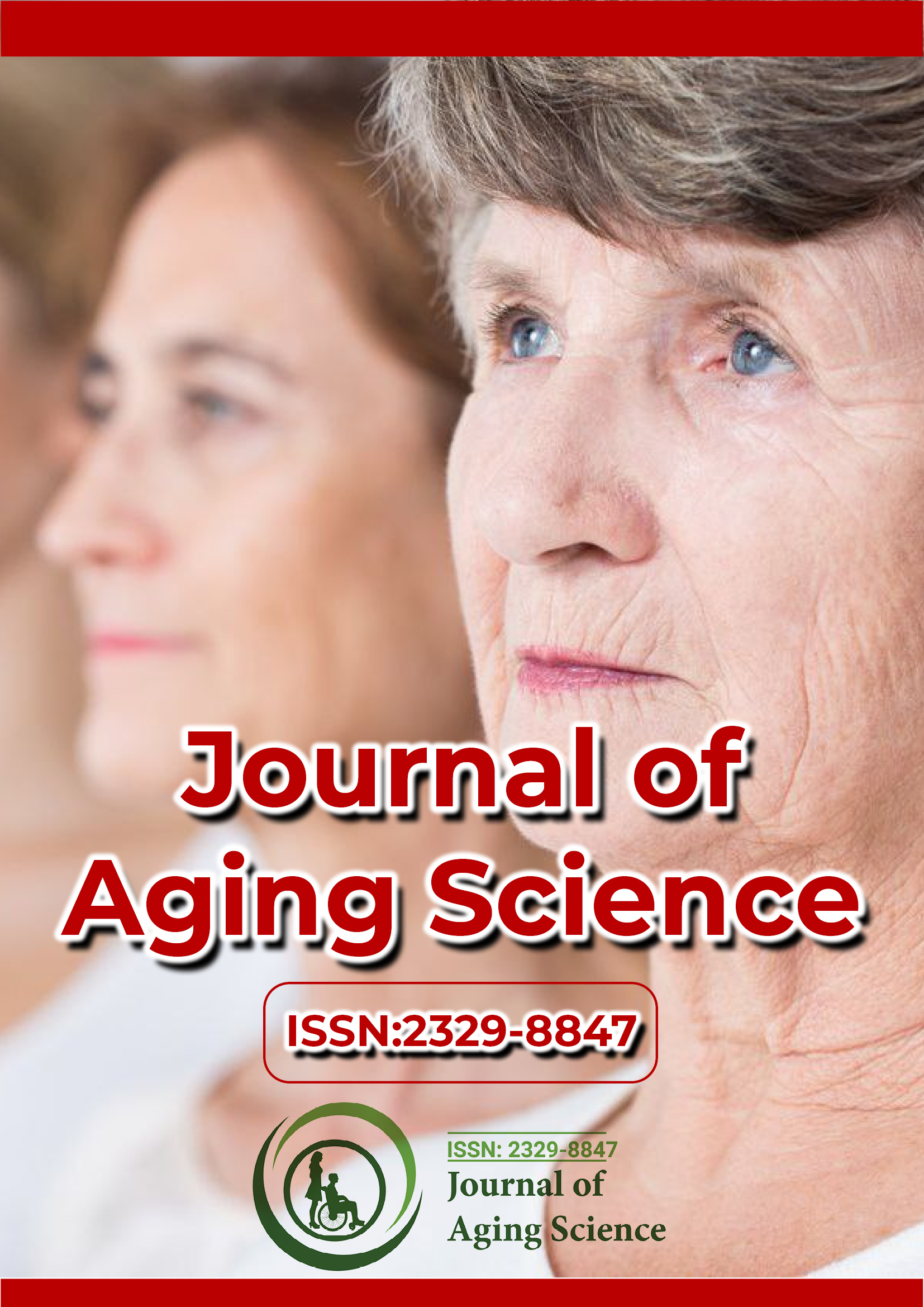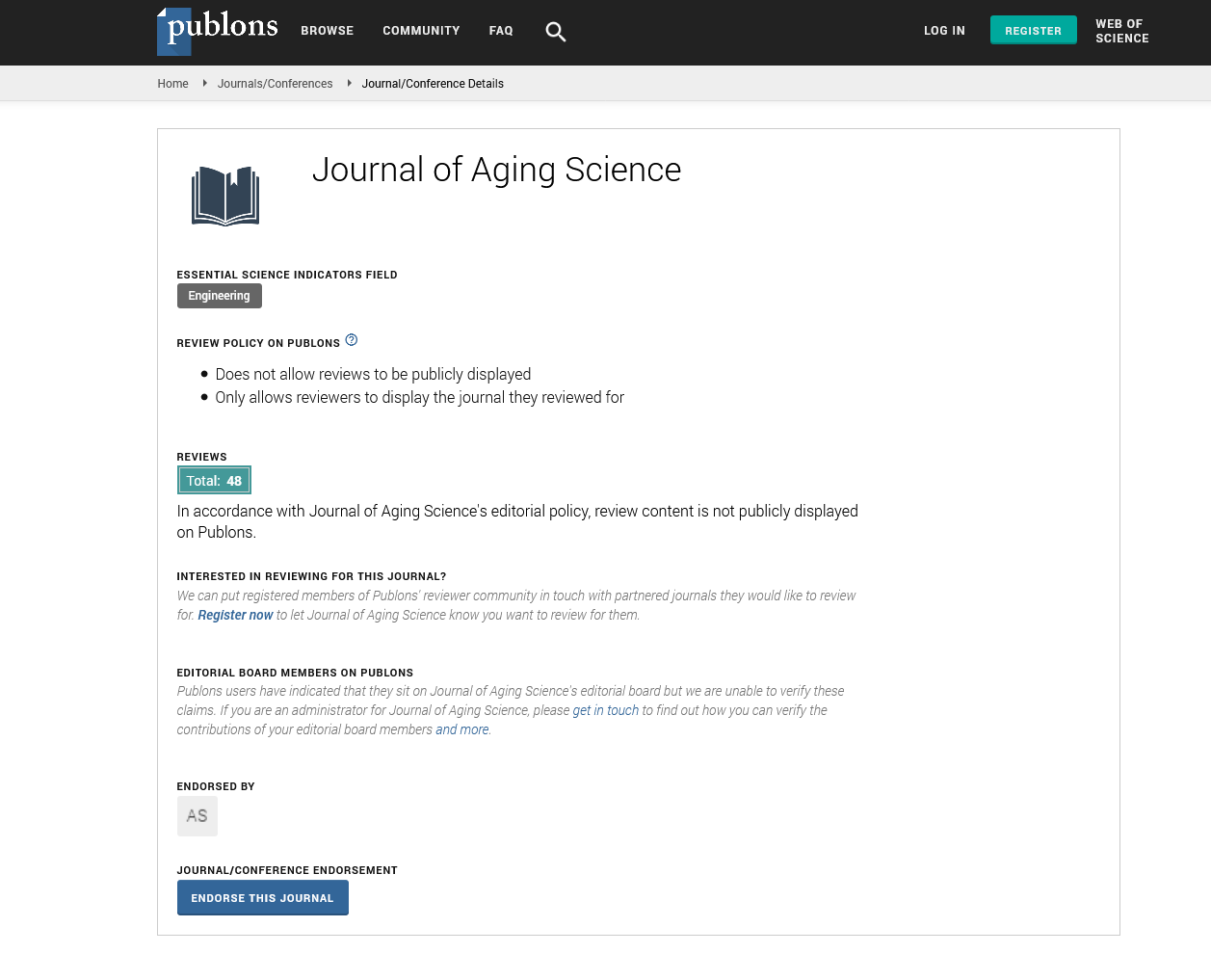Indexed In
- Open J Gate
- Academic Keys
- JournalTOCs
- ResearchBible
- RefSeek
- Hamdard University
- EBSCO A-Z
- OCLC- WorldCat
- Publons
- Geneva Foundation for Medical Education and Research
- Euro Pub
- Google Scholar
Useful Links
Share This Page
Journal Flyer

Open Access Journals
- Agri and Aquaculture
- Biochemistry
- Bioinformatics & Systems Biology
- Business & Management
- Chemistry
- Clinical Sciences
- Engineering
- Food & Nutrition
- General Science
- Genetics & Molecular Biology
- Immunology & Microbiology
- Medical Sciences
- Neuroscience & Psychology
- Nursing & Health Care
- Pharmaceutical Sciences
Commentary - (2025) Volume 13, Issue 3
Immunosenescence in Aging: Declining Immune Defenses and Strategies for Restoration
Sam Willing*Received: 30-Jul-2025, Manuscript No. JASC-25-29553; Editor assigned: 03-Jul-2025, Pre QC No. JASC-25-29553 (PQ); Reviewed: 17-Jul-2025, QC No. JASC-25-29553; Revised: 24-Jul-2025, Manuscript No. JASC-25-29553 (R); Published: 31-Jul-2025, DOI: 10.35248/2329-8847.25.13.415
Description
The immune system is central to protecting the body against infections, maintaining tissue homeostasis and detecting abnormal cellular changes. With advancing age, the immune system undergoes a progressive decline in efficiency, a process referred to as immunosenescence. This age-related weakening contributes significantly to increased vulnerability to infections, poorer vaccine responses, higher incidence of autoimmune disorders and greater risk of cancer in older adults. Understanding immunosenescence is essential for developing strategies that promote healthier aging and extend the years of functional independence.
One of the hallmark changes in aging immunity is the reduction in adaptive immune capacity. The thymus, an organ crucial for T-cell maturation, undergoes involution after puberty, shrinking in size and function. As a result, older adults produce fewer naïve T-cells, which are essential for responding to novel pathogens. Instead, the immune repertoire becomes dominated by memory T-cells, particularly those targeting persistent infections such as Cytomegalovirus (CMV). This imbalance limits the immune system’s ability to mount responses against new infectious agents.
Similarly, the B-cell compartment is affected. With age, bone marrow production of B-cell precursors declines and existing B-cells exhibit reduced ability to generate high-affinity antibodies. This impairs the humoral immune response, making vaccinations less effective and recovery from infections slower. Older individuals often show diminished antibody diversity, leading to inadequate long-term protection after exposure to pathogens or immunizations.
The innate immune system, the body’s first line of defense, is also altered during aging. Natural Killer (NK) cells, macrophages and neutrophils may still be present in adequate numbers, but their function declines. Neutrophils exhibit slower chemotaxis, reduced phagocytic activity and less efficient microbial killing. NK cells show diminished cytotoxic activity, limiting their ability to eliminate virus-infected or malignant cells. These changes reduce the immediate defensive response and contribute to increased susceptibility to disease.
Aging is also accompanied by a persistent state of low-grade inflammation, often referred to as “inflammaging”. Elevated levels of pro-inflammatory cytokines such as IL-6 and TNF-α create a systemic environment that impairs immune function while simultaneously predisposing individuals to chronic diseases such as atherosclerosis, diabetes and neurodegeneration. The interplay between immunosenescence and inflammaging forms a cycle in which declining immune surveillance allows tissue damage and ongoing inflammation accelerates aging processes.
The decline in immune efficiency also affects the body’s ability to detect and eliminate malignant cells. Immune surveillance normally identifies and destroys cells with oncogenic mutations. However, with aging, weakened T-cell function and reduced NK cell activity increase cancer risk. This explains, in part, why cancers are more prevalent in older populations.
Beyond infections and cancer, immunosenescence contributes to increased autoimmunity in aging. A weakened immune system paradoxically allows the survival of autoreactive lymphocytes that would normally be eliminated, leading to conditions such as rheumatoid arthritis or autoimmune thyroid disease. Thus, the aging immune system demonstrates a complex imbalance too weak to effectively fight infections yet prone to inappropriate self-directed activity.
Vaccination responses provide clear evidence of immune decline. While vaccines remain beneficial for older adults, immune senescence reduces both the strength and duration of vaccine-induced protection. For example, influenza and pneumococcal vaccines are less effective in older adults compared to younger populations. This has led to the development of higher-dose vaccines or formulations with adjuvants to enhance immune responses in elderly populations.
At the molecular and cellular level, telomere shortening, mitochondrial dysfunction and DNA damage in immune cells contribute to reduced proliferative capacity and impaired function. Epigenetic changes further alter gene expression patterns, reshaping immune cell behavior with age. These molecular hallmarks highlight the deep biological roots of immunosenescence and its connection to the broader aging process.
Interventions to counteract immunosenescence are being actively explored. Lifestyle factors such as regular physical activity, balanced nutrition and adequate sleep can support immune resilience. Micronutrients including zinc, vitamin D and omega-3 fatty acids play roles in immune regulation and deficiencies are more common in older adults. Caloric restriction and intermittent fasting, studied in animal models, show potential for enhancing immune function, though translation to humans remains under investigation.
Social and psychological factors should not be overlooked. Chronic stress and isolation, both of which are more common in older age, negatively impact immune health by altering cortisol regulation and suppressing immune responses. Maintaining mental well-being, social connections and stress management are therefore integral components of supporting immune function in aging populations.
Conclusion
Immunosenescence is a defining aspect of biological aging, shaping susceptibility to infections, cancer, autoimmunity and diminished vaccine efficacy. It involves changes across both innate and adaptive immunity, including reduced T- and B-cell diversity, altered innate cell function and persistent low-grade inflammation. Together, these alterations weaken the immune system’s ability to protect the body, leaving older individuals more vulnerable to disease.
Although immune decline is an inevitable part of aging, its impact can be modulated. Lifestyle interventions such as regular exercise, proper nutrition and stress reduction play a meaningful role in supporting immune resilience. Advances in medical research, including targeted immunotherapies and strategies to reverse cellular aging, hold potential to mitigate immunosenescence in the future.
Ultimately, understanding and addressing immunosenescence is central to promoting healthy aging. By strengthening immune defense and reducing vulnerability to disease, individuals can experience not only longer lives but also improved quality of life in later years.
Citation: Willing S (2025). Immunosenescence in Aging: Declining Immune Defenses and Strategies for Restoration. J Aging Sci. 13:415.
Copyright: © 2025 Willing S. This is an open-access article distributed under the terms of the Creative Commons Attribution License, which permits unrestricted use, distribution and reproduction in any medium, provided the original author and source are credited.

